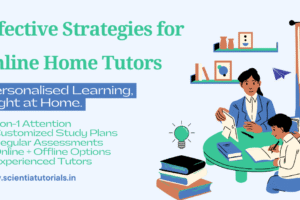Personalizing Lessons for Success: Teaching Tips for Home Tutors on Different Learning Styles
Introduction
Every student is unique, with distinct learning styles and preferences that influence how they absorb information. As a home tutor, understanding these differences is crucial to effectively engage and support each learner. Personalizing lessons according to individual learning styles not only enhances student understanding but also boosts motivation and confidence. This article explores various learning styles, practical teaching tips for personalizing lessons, and strategies to create an inclusive and effective learning environment for all students.
1. Understanding Different Learning Styles
Learning styles refer to the various ways individuals process information. While many models exist, one of the most popular frameworks categorizes learners into four primary styles: visual, auditory, reading/writing, and kinesthetic (often abbreviated as VARK). Recognizing these styles helps tutors tailor their approaches to better suit each student’s needs.
a. Visual Learners
Visual learners prefer to see and visualize information. They benefit from diagrams, charts, videos, and illustrations. These learners often think in images and can quickly recall visual information.
b. Auditory Learners
Auditory learners thrive on listening and verbal communication. They grasp information better through discussions, lectures, and audio materials. These learners often enjoy reading aloud and benefit from rhythmic patterns and sounds in their learning.
c. Reading/Writing Learners
Reading/writing learners favor written words and texts. They excel in activities that involve reading, note-taking, and writing. These learners appreciate handouts, articles, and books, and they often engage deeply with written material.
d. Kinesthetic Learners
Kinesthetic learners learn best through hands-on experiences and physical activities. They prefer to touch, manipulate, and experiment with materials to understand concepts. These learners often find it difficult to sit still for long periods and thrive in interactive environments.
2. The Importance of Personalizing Lessons
Personalizing lessons for different learning styles is essential for several reasons:
a. Enhances Engagement
When students learn in a way that resonates with them, they are more likely to be engaged and interested in the material. Personalized lessons help maintain attention and motivation, leading to a more productive learning experience.
b. Improves Understanding and Retention
Tailoring lessons to fit individual learning styles allows students to grasp concepts more effectively. They are more likely to retain information when it is presented in a format that aligns with their preferences.
c. Builds Confidence
Personalized learning fosters a sense of achievement and boosts students’ confidence. When learners succeed in understanding material presented in a way they can relate to, they are more likely to take risks and participate actively in their education.
d. Supports Diverse Needs
Every student has unique strengths and weaknesses. By personalizing lessons, tutors can address individual challenges and provide appropriate support, creating an inclusive learning environment.
3. Strategies for Personalizing Lessons
To effectively personalize lessons for different learning styles, tutors can employ several strategies. Here are practical tips for adapting your teaching methods:
a. Conduct Learning Style Assessments
Before beginning tutoring sessions, consider assessing the student’s learning style. Simple questionnaires or discussions about their preferences can help identify how they learn best. This foundational knowledge allows you to tailor lessons more effectively.
b. Incorporate Multi-Sensory Approaches
To accommodate various learning styles, blend multiple teaching methods within your lessons. For example, combine visual aids (like charts or videos) with auditory elements (like discussions or storytelling) and hands-on activities (like experiments or projects). This multi-sensory approach engages all learners and reinforces understanding.
c. Utilize Visual Aids
For visual learners, create and use visual aids to enhance your lessons. This can include:
- Charts and Graphs: Presenting data visually can help clarify complex information.
- Diagrams and Mind Maps: These tools can organize thoughts and show relationships between concepts.
- Videos and Slideshows: Incorporate multimedia to illustrate ideas and make learning more dynamic.
d. Encourage Auditory Learning Techniques
To support auditory learners, employ strategies such as:
- Discussion and Dialogue: Engage students in conversations about the subject matter to reinforce learning through verbal exchange.
- Read Aloud: Encourage reading aloud or provide audiobooks to aid comprehension.
- Use Rhymes or Songs: Incorporating music or rhymes can help auditory learners remember information more easily.
e. Incorporate Reading and Writing Activities
For reading/writing learners, include activities that focus on texts and written expression:
- Assigned Readings: Provide relevant articles or books that delve into the topics being studied.
- Writing Exercises: Encourage students to write summaries, essays, or reflections to solidify their understanding.
- Note-Taking Strategies: Teach effective note-taking techniques that help them organize information.
f. Engage Kinesthetic Learners
To reach kinesthetic learners, implement hands-on activities that allow them to engage physically with the material:
- Experiments and Projects: Incorporate science experiments or creative projects that require active participation.
- Role-Playing: Use role-playing activities to help students understand complex concepts by acting them out.
- Movement-Based Learning: Include activities that allow students to move around the space while learning, such as scavenger hunts or interactive games.
4. Creating a Personalized Learning Environment
Beyond lesson personalization, creating a supportive learning environment is crucial for fostering student success. Here are tips to help cultivate an inclusive atmosphere:
a. Establish Rapport
Building a strong relationship with your student is essential. Take the time to learn about their interests, hobbies, and goals. This connection creates a safe space where students feel comfortable expressing their thoughts and asking questions.
b. Adapt to Individual Needs
Remain flexible in your teaching approach. If a particular method isn’t working for a student, be willing to adjust your strategies based on their feedback and progress. Continuously evaluate what resonates with your student and be open to change.
c. Encourage Self-Reflection
Prompt students to reflect on their learning experiences. Ask questions like, “What strategies helped you understand this concept?” or “How do you prefer to learn?” Encouraging self-reflection helps students become more aware of their learning preferences and fosters a sense of ownership in their education.
d. Provide Constructive Feedback
Regularly offer feedback on students’ progress. Highlight their strengths while providing constructive suggestions for improvement. Acknowledging achievements fosters motivation and encourages them to continue working towards their goals.
5. Leveraging Technology for Personalized Learning
In today’s digital age, technology can play a significant role in personalizing lessons for different learning styles. Consider the following tools and resources:
a. Educational Apps and Platforms
Utilize apps that cater to various learning styles. For example, visual learners may benefit from apps that feature infographics, while auditory learners might find podcasts or audiobooks helpful.
b. Online Resources and Multimedia
Incorporate online videos, interactive simulations, and educational games into your lessons. These resources can enhance understanding and cater to different learning preferences.
c. Learning Management Systems
If you are working with multiple students, consider using a learning management system (LMS) to track progress and customize lesson plans. LMS platforms often allow you to create personalized pathways for each student based on their learning styles and preferences.
6. Evaluating Progress and Adapting Approaches
As a home tutor, it’s important to continuously evaluate your students’ progress. Assess their understanding and retention of material regularly, using a combination of formative assessments (quizzes, discussions) and summative assessments (projects, tests). This evaluation will provide insight into their learning styles and help you make necessary adjustments.
a. Feedback Loops
Establish regular feedback loops with your students. Encourage them to share their thoughts on what methods work best for them and what they find challenging. This communication ensures that you remain attuned to their needs and can adapt your approach accordingly.
b. Adjusting Goals and Objectives
As students progress, be prepared to adjust their learning goals and objectives. Celebrate milestones, but also reassess goals to ensure they remain relevant and challenging. This ongoing adaptation keeps students motivated and engaged.
Conclusion
Personalizing lessons for different learning styles is a vital aspect of effective home tutoring. By understanding the diverse ways students learn, tutors can create engaging and meaningful learning experiences that cater to individual needs. Through various strategies—such as utilizing visual aids, engaging in discussions, incorporating hands-on activities, and leveraging technology—home tutors can enhance student engagement and retention. Ultimately, personalizing lessons fosters a positive learning environment where students feel empowered to take ownership of their education, build confidence, and achieve their academic goals.



